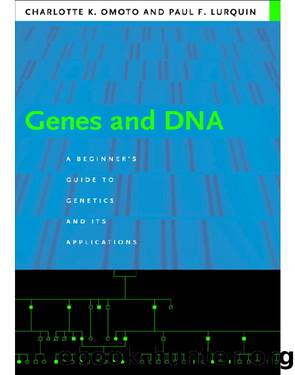Genes and DNA by Omoto Charlotte K.;Lurquin Paul F.;

Author:Omoto, Charlotte K.;Lurquin, Paul F.;
Language: eng
Format: epub
Tags: SCI029000, Science/Life Sciences/Genetics and Genomics, SCI008000, Science/Life Sciences/Biology/General
Publisher: Lightning Source Inc. (Tier 3)
Published: 2004-05-16T16:00:00+00:00
Teratogens
Mutagenic agents are not the only source of birth defects and spontaneous abortions. Some substances are more properly classified as teratogens instead of mutagens. Teratogens are substances that cause malformation of the developing embryo but do not act through changes in the DNA. A helpful analogy to understand the difference between teratogens and mutagens is to consider a building and its blueprint. A mutagen changes the DNA blueprint for an organism. The building or organism is flawed because the originally correct blueprint is altered. A teratogen does not alter the blueprint, but rather causes a defect in the building by providing faulty materials or making mistakes in the building process. Both teratogens and mutagens may cause spontaneous abortion, severe malformation of the embryo, or mental retardation of the baby, but the underlying mechanisms are very different.
Why do substances, some of which do not cause any problems in an adult nor cause changes in the DNA, cause major defects in a developing embryo? Early developmental processes have an immense effect on the individual, both mentally and physically. Remember that each of us begins as a fertilized egg that must divide many times in order to make all the different cells of our body. In order to develop properly, cells must interact with neighboring cells, and some must even move over other cells to be accurately positioned. These cellular activities are very prominent early in embryonic development. Any untoward influence on cells during these critical early stages will affect the processes in progress and a great percentage of cells in the developing embryo.
An example of a tragic teratogen is thalidomide, a medication formerly prescribed for nausea. This medication is perfectly safe for adults, and so it was prescribed for morning sickness to pregnant women in late 1950s and early 1960s. It was only after a spurt of babies were born with deformed limbs that anyone realized that thalidomide is a strong teratogen. It turns out that the teratogenic effect occurs in the very earliest days of pregnancy, when limbs are just developing and when the mother may not even be aware that she is pregnant. It is now thought that thalidomide affects the formation of blood vessels, a critical process in early development. Because of this effect, thalidomide is now being considered for cancer treatment, since tumors also need a good blood supply to grow.
Download
This site does not store any files on its server. We only index and link to content provided by other sites. Please contact the content providers to delete copyright contents if any and email us, we'll remove relevant links or contents immediately.
| Administration & Medicine Economics | Allied Health Professions |
| Basic Sciences | Dentistry |
| History | Medical Informatics |
| Medicine | Nursing |
| Pharmacology | Psychology |
| Research | Veterinary Medicine |
Tuesdays with Morrie by Mitch Albom(4397)
Yoga Anatomy by Kaminoff Leslie(4100)
Science and Development of Muscle Hypertrophy by Brad Schoenfeld(3970)
Bodyweight Strength Training: 12 Weeks to Build Muscle and Burn Fat by Jay Cardiello(3779)
Introduction to Kinesiology by Shirl J. Hoffman(3626)
How Music Works by David Byrne(2963)
Sapiens and Homo Deus by Yuval Noah Harari(2842)
The Plant Paradox by Dr. Steven R. Gundry M.D(2425)
Insomniac City by Bill Hayes(2394)
Churchill by Paul Johnson(2360)
Coroner's Journal by Louis Cataldie(2357)
The Chimp Paradox by Peters Dr Steve(2222)
Hashimoto's Protocol by Izabella Wentz PharmD(2197)
The Universe Inside You by Brian Clegg(2048)
The Immune System Recovery Plan by Susan Blum(1963)
Don't Look Behind You by Lois Duncan(1914)
The Hot Zone by Richard Preston(1907)
Endure by Alex Hutchinson(1869)
Woman: An Intimate Geography by Natalie Angier(1839)
